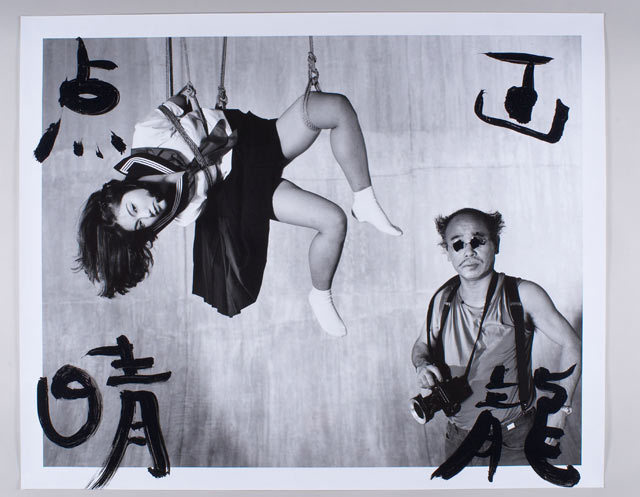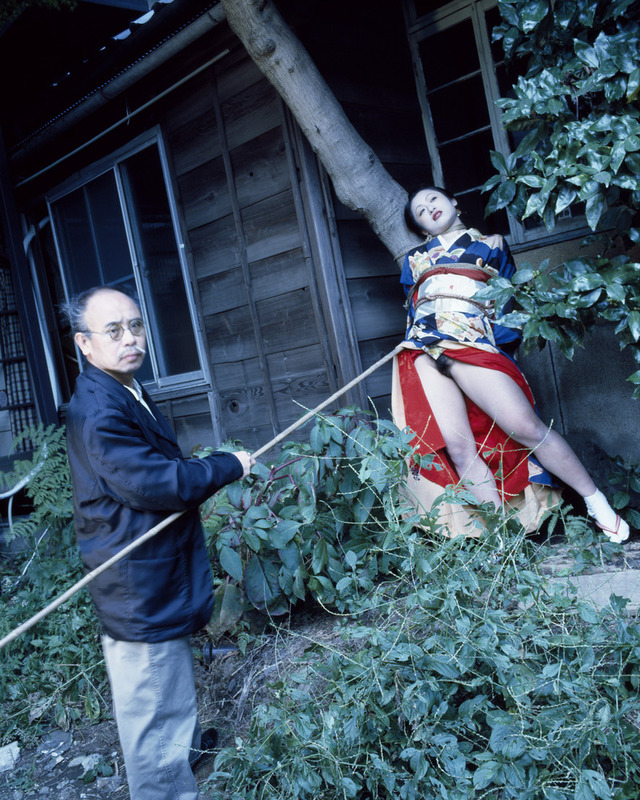Japanese Modernism Across Media
"Dirty old man" ?
"In 1992, when the Japanese photographer Nobuyoshi Araki presented a series of loud, intermittently shocking images at a gallery in Austria, the institution's female guards walked out. Araki's photographs were sexist, degrading, oppressively fetishistic, they argued; if the work was installed, they wouldn't be coming back."
--The Guardian, Alex Moshakis, "Is Nobuyoshi Araki's Photography Art or Porn?"
Araki: my art is more than pornography
Though many accuse his works for pornographic obscenity, Araki himself insists: “My photography reveals everything, differently from typical pornography. There is a Japanese proverb, ‘Hiding makes it flower (秘すれば花).’ [If you hide something, it becomes more valuable and beautiful.] But my models and photographs show everything.” Araki argues that the subjects' absolute openness in his works does not aim to be sexually provocative, and neither are his photographs meant to shock or to repel.
Perhaps Araki does have a point there. Maybe concluding the artist’s works into mere representations of graphic eroticism is somehow misunderstanding the artist’s true genius.
Araki seems to suggest that, what is provocative in his photographs is not just the lust for sex, but rather the intimacy between the photographer and his subjects, the aura of lingering desire and growing openness between two giving individuals.
- Love, rather than Lust
“it is Yoko who made him a photographer. Without Yoko, he would not realize his photography.” For Araki, his photographic eroticism is from the start the documentation of vivid and intimate connections between people. The fact that one of such connections is now impeded by the death of his wife only lends this dominant theme in his art more delicacy. It reminds us of the transcendence of spiritual connections as opposed to the temporality of the portrayed physical closeness.
- Connections in space & time
Indeed, Araki now has a growing fascination towards “time”, and he has shifted his focus on the connections of himself to those of others, opening up the scale of the intimacy.In his latest work, Kofuku Shashin (Happy Photographs), Araki’s works is no longer about nude females tied up in enclosed space, but about ordinary people’s daily life in the open streets of Tokyo. “I came to realize that I can get much more out of the shoot if I focus on the relationship that my subjects have among themselves, rather than the relationship between them and me,” says Araki. “I shoot that moment. That’s far more profound. Of course the spatial relationship that we create for ourselves at that moment is also important, but the time that we share together is far more appealing and precious to me...it’s like I frame ‘time’ rather than ‘space.’”
- Intimacy beyond Sex
From the immobile models to the families playing together, Araki seems to be reaching into another realm of “intimacy”. It is less about physical openness built through body exposure and spatial tightness, but more about self-erasure from the narratives of others, an openness that transcends the boundaries between self and other, as well as that between professional photographs and frameless living environment and quotidian activities.
Art As An Excuse for Self Indulgence?
However, Araki’s explanation on what distinguishes his art from pornography does not apply to all his works; in fact, there are quite a lot of exceptions for both his photos and Shunga, where neither do his models look audacious, nor do the females in traditional erotic art pieces look shy and “hidden” with their bodies barely covered up.
- Objectification of Females
The cases where some of Araki has models their heads covered or faces turned away are far from rare. With their entire face intentionally erased from the image, the women’s identities are obscured, their voices muffled. While their nakedness reveals everything about their physicality, the models are but only bodies without names, losing their remaining agency as a subject. Even their bodies are reduced to the totalitarian concept of sexualization. In images like these, it is hard for Araki to convince his audience that his erotic photos are not pornography that dehumanizes and objectifies women.
- Kinbaku: Tying Up Body or Soul?
Though Araki claims that he only ties up a woman's body and never her soul, the idea of bondage is essentially based upon the idea of immobility, the deprivation of autonomy and the imposing of control. Many of Araki’s photos that feature Kinbaku are also the ones where the models’ faces are masked or hidden, and the bondages double up the extent to which the models are objectified and dehumanized. The ropes intrudes the models’ existence, marking their images almost like an assault, while the models’ nudity makes the presence of the bags over their heads and the ropes around their bodies even more conspicuous.
Tying up the body or the soul, however, Araki’s love with Kinbaku may well be another manifestation of the photographer’s obsession with paradox. When the image of the model’s delicate body collides with that of the grotesque ropes and knots, or when the skin is freed and exposed from garments yet still strangled behind the cage-like bondages, there is a certain grace in the co-existence of pleasure and pain, comfort and danger.
- “Lecherous Old Man”
One fact that often draws harsh criticism towards the photographer is that he has slept with all of his models during the shooting sessions. “The model(s) and I expose ourselves to each other. We cannot hide anything. Even the feeling or the relation between the two is open. It also applies to the cityscapes that I make. There is always a certain naked relationship between my subjects and me.” Here Araki brings up the idea of exposure and intimacy again. But is it really necessary for the photographer to go that far in his radical experiment? And is such experiment sincerely just for art?
The possibility that Araki is using art as an excuse for his own indulgence in sex is hardly ignorable, given that the artist is never ambiguous about his craze over women. “I immediately get a hard-on if I touch the girl,” says Araki during an interview,“…A photographer who doesn’t take photos of women is no photographer, or only a third-rate one. Women teach you much more about the world than reading Balzac’s Human Comedy.”
Moreover, Araki’s self-indulgence seems to extend way beyond off-camera. The image of his “alter-ego,” reptiles, frequently appears in his photographs. Araki is never subtle about the sexual connotation of these toy reptiles and the phallic image they stand for. Inspired by the tradition of animism in Edo Japanese prints, these monster figures in Araki's works are equivalence of human desires—including that of his own.


![[Untitled] [Untitled]](https://ds-omeka.haverford.edu/japanesemodernism/files/fullsize/3713d81132fd93a22843bcacd175241e.jpg)

![[Untitled] [Untitled]](https://ds-omeka.haverford.edu/japanesemodernism/files/fullsize/6dce3155a40cf1660a1f72b3adc15b79.jpg)

![[Untitled] [Untitled]](https://ds-omeka.haverford.edu/japanesemodernism/files/fullsize/1a0fd00e4ae2d81e037ba2ce2db90339.jpg)
